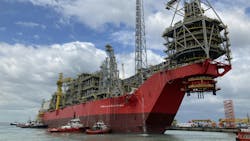Editor's note: This Global E&P section first appeared in the January-February 2024 issue of Offshore magazine. Click here to view the full issue.
By Jeremy Beckman, London
NORTH AMERICA
Shell and Equinor are moving ahead with the deepwater Sparta development in the Garden Banks area of the US Gulf of Mexico. Seatrium in Singapore will construct the semi-submersible floating production unit: this will largely replicate Shell’s Whale FPU which is due to start operating in the Perdido corridor later in the year. Sparta’s platform, located 275 km (171 m) offshore Louisiana in over 1,400 m (4,700 ft) of water, will be Shell’s first in the GOM to produce from reservoirs with pressures of up to 20,000 lb/sq in. The two-level topside will also feature all-electric compression equipment to reduce emissions, and will have capacity to produce 90,000 boe/d.
Elsewhere in the sector, Shell and partners Chevron and bp have sanctioned three new production wells through the Perdido spar platform, 200 mi (322 km) south of Galveston in 8,000 ft (2,438 m) water depth. These will be drilled in the Great White unit area, delivering an additional 22,000 boe/d at peak.
***
Talos Energy has produced first oil and gas from its Lime Rock and Venice subsea tiebacks to the Ram Powell platform, at an initial combined rate of over 18,500 boe/d. And the company has moved to boost its GoM production further by acquiring privately-owned QuarterNorth Energy, which operates the deepwater Katmai discovery in the Green Canyon region and has interests in other fields such as Gunflint and Galapagos, for $1.29 billion.
SOUTH AMERICA
Four companies have signed PSCs with state-owned Staatsolie under Suriname’s Demerara bid round in the offshore Guyana-Suriname basin. Petronas gained 100% of Block 63, 200 km offshore in water depths of around 1,700 m, and participation in Block 64, 250 km (124 mi) from the shore in 1,300 m (4,265 ft) of water. TotalEnergies operates, QatarEnergy is the other partner: both concessions carry a commitment to drill a well in the initial three-year exploration phase. Shell subsidiary BG International operates the shallower-water Block 65 alongside QatarEnergy, and will drill a well in the second exploration period. Staatsolie also expects TotalEnergies and partner APA Corp to take FID on their first deepwater development in Block 58 by the end of this year.
***
Brazil too has made awards under the ANP’s 4th Permanent Concession Offer Cycle. Petrobras will operate 29 blocks in the frontier offshore Pelotas basin shared with Uruguay, all in partnership with Shell and CNOOC, with Chevron named operator for 15 further blocks. Other operatorships in the Santos basin to the north went to CNOOC, Equinor and Karoon Energy.
Petrobras has produced first oil from the second full-scale FPSO development on the Mero field in the Libra block in the Santos basin pre-salt. The Sepetiba, supplied by and on charter from SBM Offshore, is stationed over 180 km (112 mi) from the coast of Rio de Janeiro, with capacity to produce 180,000 b/d of oil and compress 12 MMcf/d of gas for re-injection of the associated CO2-rich gas. Mero-2 will lift overall production from the field above 400,000 b/d, with two more FPSOs under construction and set to add 180,000 b/d each by 2025.
Yinson expected the converted FPSO Atlanta to depart Drydocks World in Dubai in the current quarter for Enauta’s Atlanta field in the Santos basin. The vessel includes a carbon management plant that employs fuel gas for cargo tank inertization, and a closed flare system.
***
The four-legged jacket, topsides, piles and pre-installed risers for the Fenix wellhead platform offshore southern Argentina sailed from eastern Italy early last month onboard the transport vessel Interocean II. Rosetti Marino built the structures for operator TotalEnergies, which is developing the Fenix field via three horizontal wells. Gas production, due to start early 2025, will head through a new 35-km pipeline to the company’s Véga Pleyade platform off Tierra del Fuego.
WEST AFRICA
Energean has agreed to farm in as operator to two licenses offshore Morocco, Lixus and Rissana. The company will carry current incumbent Chariot for its share of pre-FID costs of up to $85 million for the Anchois gas field in the Lixus permit, including a planned appraisal well this year on the field’s east flank, targeting up to 11 bcm from two undrilled prospects. Chariot and state-owned ONHYM will remain partners.
***
Late last year the FPSO Léopold Sédar Senghor departed the Seatrium shipyard in Singapore for Woodside’s Phase 1 deepwater Sangomar oilfield development, 100 km (62 mi) offshore Senegal. The vessel, converted from a VLCC, will process 100,000 b/d and store at least 1.3 MMbbl of oil, and should start operations in mid-year.
***
Akrake Petroleum, a subsidiary of Porto Novo Resources, plans a redevelopment of the shallow-water Sèmè oilfield offshore Benin after signing a PSC for the surrounding Block 1. Norway’s Saga Petroleum developed the field, producing around 22 MMbbl between 1982 and 1982, before shutting down operations due to a heavy fall in the oil price. Initially, production should resume through a jackup MOPU, horizontal wells and modern completions for water control, to maximize recovery, with the oil stored on an FSO.
***
Tower Resources has contracted Borr Drilling’s jackup Norve to drill the NJOM-3 appraisal well on the Thali license offshore Cameroon, after the rig completes programs for other clients. Tower also aims to bring in partners to the Thali license to co-fund drilling and a subsequent development.
***
Eni expected to produce the first LNG cargo this quarter from the FLNG Tango, moored offshore Congo. The vessel, with a liquefaction capacity of almost 1 bcm/yr, is the first phase of the Congo LNG project which harnesses gas produced from the Marine XII offshore permit. It is moored alongside the Excalibur FSU. A second FLNG, with a 3.5-bcm capacity, is under construction and should begin operating in 2025.
***
Galp Energia has added to the growing inventory of deepwater oil discoveries in the Orange basin. The Mapane-1X well in Petroleum Exploration License 83 was due to undergo a DST to determine commercial viability of the light oil find before drilling continued into deeper targets. The license is north of three Shell-operated discoveries in PEL39 and west of Venus-1 in the TotalEnergies-led PEL 56.
NORTHWEST EUROPE
Equinor aimed to close a transaction this quarter with Norske Shell for the latter’s 30% operated interest in the Linnorm gas field in the Norwegian Sea. Linnorm, discovered in 2005, is said to be Norway’s largest undeveloped gas resource with up to 30 bcm thought recoverable. As the new operator, Equinor and partners Petoro and TotalEnergies will consider a subsea tieback to either the Kristin or Åsgard B semisubmersible platforms.
***
Malaysian independent Ping Petroleum has conditionally agreed to take an 81.25% operated interest from Orcadian Energy in the heavy-oil Pilot field development in UK license P2444. Orcadian estimates recoverable reserves at over 78 MMbbl, with upside potential. The two companies will work to deliver a field development plan involving a polymer flood.
RockRose UKCS, a subsidiary of Viaro Energy, has agreed to farm into 15% of Bressay, another heavy oil field located in the UK’s East Shetland basin, paying operator EnQuest $56.4 million. Bressay is one of the UK’s largest undeveloped fields and could potentially produce around 200 MMboe, according to Viaro. It estimates capex for an early production system at $762 million.
ASIA-PACIFIC
Shapoorji Pallonji Energy’s FPSO Armada Sterling V has produced first oil for ONGC at the deepwater KG-DWN-98/2 block offshore Kakinada, eastern India. The vessel has a liquids processing capacity of around 60,000 b/d and gas capacity of 3 MMcm/d. It is co-owned by SP Energy’s 70:30 joint venture with Malaysia’s Bumi Armada group, and is the company’s third FPSO to operate in Indian waters. ONGC is developing the waxy crude in the M field using pipe-in-pipe technology.
***
PTTEP KH Offshore has discovered three oil and gas fields offshore Sarawak via the Chenda-1 well in block SK405B, and the Bangsawan-1 and Babadon-1 wells in SK438. All are close to previous finds made by the company, with Babadon-1 containing sweet gas sandstone reservoirs up to 200 m (656 ft) thick, the largest PTTEP has proven to date in the region following its Lang Lebah breakthrough discovery.
In addition, the company has signed development agreements with Petronas Carigali. One is an MoU concerning exports of production from SK405B through existing facilities to the Petronas-operated Bintulu onshore crude oil terminal and a technical study of design requirements for connecting the block’s discoveries to the facilities. The other agreement covers engineering design support for taking gas and condensate from Lang Lebah in block SK410B to Bintulu.
Malaysia Marine and Heavy Engineering (MMHE) has contracted McDermott to perform transport and installation of facilities for Petronas Carigali’s Kasawari carbon capture and storage project offshore Sarawak. The scope of work covers a 138-km (85-mi) section of pipeline, the 15,000-metric ton CCS platform jacket, and the bridge connection to the existing central processing platform. Kasawari CCS is designed to cut carbon dioxide emitted via flaring by 3.3 Mt/CO2e/yr.
***
CNOOC has started production from the Lufeng Oilfields Phase II development in the eastern South China Sea, in a water depth of 136 m (446 ft). The company installed a new drilling platform and plans to eventually have 13 producer wells and one water injector in service, supporting peak production of around 22,600 b/d by 2025.
***
Mubadala Energy has made a potentially giant gas discovery - over 6 tcf - with Layaran-1, its first deepwater exploration well in the Andaman Sea, 100 km (62 mi) offshore North Sumatra, Indonesia. The well was drilled in 1,207 m (3,960 ft) of water in the South Andaman Gross Split PSC and to a depth of 4,208 m (13,806 ft), encountering a gas column over 230 m thick in an Oligocene sandstone reservoir. It follows Mubadala’s Timpan-1 gas find last year elsewhere in the Andaman area.
About the Author
Jeremy Beckman
Editor, Europe
Jeremy Beckman has been Editor Europe, Offshore since 1992. Prior to joining Offshore he was a freelance journalist for eight years, working for a variety of electronics, computing and scientific journals in the UK. He regularly writes news columns on trends and events both in the NW Europe offshore region and globally. He also writes features on developments and technology in exploration and production.

